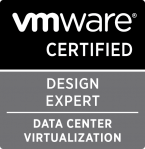Reading Time: 7 minutesDuring this years, some legacy components of the vSphere suite has been dropped, starting from removing (in vSphere 5.0) VCB, Converter Enterprise, Guided Consolidation, and the historical ESX Server. The latest removal was the TPS memory management (in vSphere 5.5 with latest patches). In those year the old vSphere Client (the Windows client side) has been deprecated (from vSphere 5.1) and all new features and functions has been introduced only in the vSphere Web Client that is a web oriented client, multi browser and multi platform. But for several operational tasks and for all the […]
Browsing Posts in VMware
Reading Time: 5 minutesAs you probably now the vSphere Fault Tolerance features has been unchanged from the first version (in vSphere 4.x)… untill now. With vSphere 6.0, recently announced, there is a new Multi-Processor FT (SMP-FT) features that replace the previous one and brings now continuous availability protection for VMs with up to 4 vCPUs! It’s not something news in the virtual environments… several years ago Marathon announced the everRun MX, that was the first solution, but only for Citrix XenServer. Initial plans of this producs expect also a vSphere version, but the company was then acquired by […]
Reading Time: 8 minutesOne of the biggest new in the new VMware vSphere 6.0 suite are probably Virtual Volumes, fundamental part of the VMware’s SDS vision. What are vSphere Virtual Volumes (or VVols)? They are an integration and management framework to convert external storage in VM-aware storage. From my point of view is the biggest news of this release (and probably the most announced, during the previous VMworld… first tech preview was in 2012!) and can really change the storage part of a virtualized design, included how it’s design. But, much important, could be a great opportunity also for […]
Reading Time: 5 minutesWith the new VMware vSphere 6.0 suite there is also a new version of VMware Virtual SAN (or VSAN) now in version 6.0 (but formally it’s a 2.0 version). Seems still a separated products, althougt my hope is that it may included in some vSphere bundle (like was with the VSA). This new version brings a lot of new features and now it’s ready also the business critical applications (version 1.0 was more targeded for ROBO, VDI, DR, testing, … scenarios).
Reading Time: 2 minutesVMware’s vision of those last years it’s almost clear and it’s all around the three main pillars: SDDC, Hybrid Cloud and EUC. In order to provide the Software Defined DataCenter, VMware has work a lot on the cloud related aspects, but also for the SDN and SDS technologies to enable a VM policies driven approach. VMware NSX is the clear answer on the SDN part, but what about the SDS part?
Reading Time: 10 minutesThe new VMware vSphere Suite 6.0 brings several changes and new features, but the installation phases remain still similar with the previous versions. The big changes are in the vCenter deployment type both for the installable and the appliance version and the new VUM client… all the other parts of the installation remain similar with only few notes.

Reading Time: 5 minutesSo not only the new releases of some VMware products have been announced… but also new certifications, new levels and new paths. The VMware certification roadmap announced at VMworld 2012 was almost clear and related to the tecnologies used (and owned by VMware) at that time. But, except the moving of the developer certification to the Pivotal initiative, the paths have been the same until now (with the new entry of Network Virtualization) and the new VCA level.










